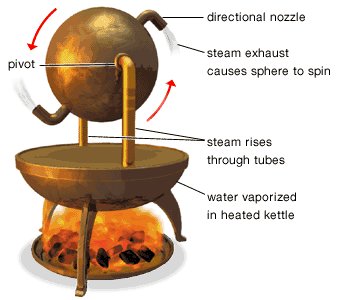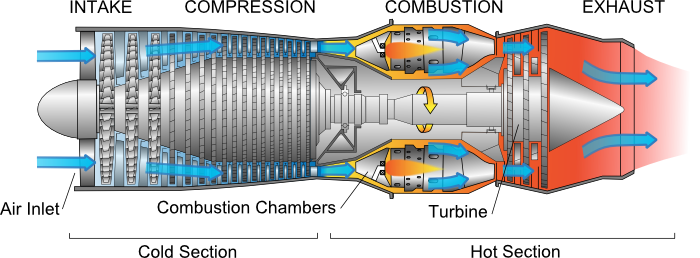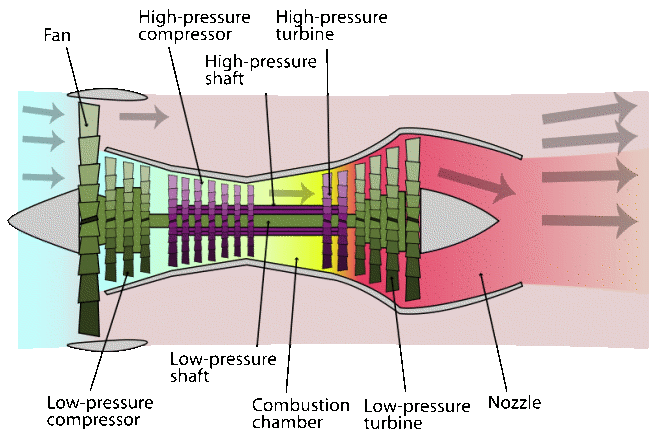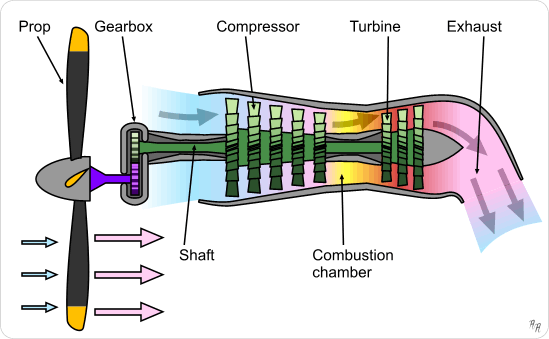Turbo Jet. The heart of the aeroplane

Newton’s third law says:
For every force acting on a body there is an equal and opposite reaction.
1600 years before any flying machine could ever fly and before Newton announced the third mechanical law, Hero of Alexandria invented the Aeolipile. Nothing serious, just a toy, but the modern jet engine use- it was the same physics principle! In Greek, the word Aeolipile means “Wind Ball”. How does this stuff work? A closed vessel filled with water is heating. After a few minutes, steam is produced and passes through two vertical outlets into the ball. Steam began to escape from the directional nozzle and the ball can rotate. Do you fancy making one?
Try to adjust the left directional nozzle and turn 180º
What would the ball do?
Some years later
Turbojet is a ‘jet engine’ or a gas turbine. It consists of: 1. An air inlet: Combustion needs air and this part of the jet engine leads the incoming air to the compressor. Once the air is in the compressor, the blades guide the airflow. 2. Air compressor. It is driven by the turbine and rotates at very high speed, adding kinetic energy to the air and compressing it into a smaller space. Compressing the air increases its temperature. 3. Combustion chamber: First, let’s make a comparison. In a full air globe, each face has equal pressure on it. The air is trying to get away in all directions. If the neck is let go, the air escapes through it and the globe moves. Between the Compressor and Combustion zones, the air is being squeezed because the volume has been reduced. Later, the volume increases and the air-fuel mixture burns increasing the temperature and pressure. But
As the mixture burns its temperature increases dramatically, but the pressure actually decreases respect to the squeeze zone. In other case, the air combustion could escape through the intake. Please, think about it
So, the compressed air inside the combustion chamber has expanded due to the enormous temperature and, as it is released out into normal atmospheric pressure, it will pass the turbines 4. Gas turbine. Hot gases leaving the Combustion chamber are allowed to expand through the turbine and cause the turbine blades to spin round. A central shaft connects the turbine to the compressor, so that the compressor is turned by energy extracted from the hot exhaust. A lot of energy is used to feed the jet engine by increasing the velocity of the exhaust gases through the nozzle. 5. Nozzle After the gas turbine, the gases increase its velocity due to a convergent nozzle. Because the exit velocity is greater than the free intake air velocity, the jet engine moves forwards.

TurboFan

It is similar to a turbojet. It consists of a large fan with a smaller turbojet engine mounted behind, so we may may that a turbofan is a Fan + a turbo jet.
Turboprop. In this case, the main shaft is directly coupled to a gearbox at the front of the jet engine to drive a propeller.

Nozzle: A short outlet pipe projecting from the end or side of a hollow vessel, such as a steam-engine cylinder.
